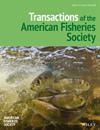影响华盛顿州斯卡吉特河流域洪泛区栖息地内溪流型幼年大鳞大麻哈鱼密度的变量
IF 1.4
3区 农林科学
Q2 FISHERIES
引用次数: 0
摘要
目标尽管经过数十年的恢复工作,西北太平洋地区的大鳞大麻哈鱼(Oncorhynchus tshawytscha)仍然受到美国濒危物种法案(ESA)的保护。斯卡吉特河流域的大鳞大麻哈鱼对普吉特海湾大鳞大麻哈鱼重要进化单元的数量和恢复起着至关重要的作用,该进化单元目前已被列入 ESA 濒危物种名单。斯卡吉特河中奇努克三文鱼的溪流型幼鱼(STJ)生活史模式在成鱼阶段的海洋存活率(即生产率)要高于稚鱼或鱼苗外迁的模式,改善 STJ 奇努克三文鱼的栖息地可增加斯卡吉特河流域的数量和多样性。方法利用斯卡吉特河流域 70 个地点的实地观测结果,我们建立了洪泛平原栖息地三个季节的广义线性混合效应模型,将变量范围与 STJ 奇努克鲑的密度联系起来。结果模型的准确性因季节而异(夏季:R2 = 0.24;冬季:R2 = 0.56;春季:R2 = 0.54),重要参数包括流速、底质、深度范围以及与主干最近连接的距离。其他重要因素包括木材覆盖率、最高水温、流速范围以及流速和深度范围的交互作用。与 STJ 大鳞大麻哈鱼最高密度相关的栖息地变量的建议范围包括:水深 40-68 厘米、流速 0.06-0.33 米/秒、底质大小 3-36 毫米以及到主干连接处的距离 33-119 米。与高幼鱼密度相关的水温因季节而异(冬季:4-6°C;夏季:9-14°C)。结论:我们建议的栖息地变量范围可用于完善旨在改善西北太平洋地区大鳞大麻哈鱼及其他鲑科鱼类幼鱼栖息地的河流恢复项目的设计。本文章由计算机程序翻译,如有差异,请以英文原文为准。
Variables influencing stream‐type juvenile Chinook Salmon density within floodplain habitat in the Skagit River basin, Washington
ObjectiveDespite decades of restoration work, Chinook Salmon Oncorhynchus tshawytscha in the Pacific Northwest remain under the protection of the U.S. Endangered Species Act (ESA). Chinook Salmon in the Skagit River basin play a vital role in the abundance and recovery of the Puget Sound Chinook Salmon Evolutionarily Significant Unit, which is currently listed as threatened under the ESA. The stream‐type juvenile (STJ) life history pattern of Chinook Salmon in the Skagit River has higher ocean survival to the adult stage (i.e., productivity) than that of parr or fry out‐migrants, and improvement in STJ Chinook Salmon habitat could increase abundance and diversity in the Skagit River basin. Our objective was to provide recommended ranges of variables shown to influence habitat selection in floodplains by STJ Chinook Salmon.MethodsUsing field observations from 70 sites within the Skagit River basin, we developed generalized linear mixed‐effects models across three seasons in floodplain habitats to correlate variable ranges with densities of STJ Chinook Salmon.ResultModel accuracy varied by season (summer: R 2 = 0.24; winter: R 2 = 0.56; spring: R 2 = 0.54), and significant parameters included velocity, substrate, depth range, and distance to the closest connection with the main stem. Additional significant factors included wood cover, maximum water temperature, velocity range, and interaction of the ranges of velocity and depth. Recommended ranges for habitat variables associated with the highest densities of STJ Chinook Salmon include depths of 40–68 cm, velocities of 0.06–0.33 m/s, substrate sizes of 3–36 mm, and distances of 33–119 m to the main‐stem connection. Water temperatures associated with high juvenile densities varied by season (winter: 4–6°C; summer: 9–14°C).ConclusionOur recommended ranges for habitat variables can be used to refine designs for river restoration projects intended to improve habitat for juvenile Chinook Salmon and other salmonids in the Pacific Northwest.
求助全文
通过发布文献求助,成功后即可免费获取论文全文。
去求助
来源期刊
CiteScore
2.90
自引率
7.10%
发文量
48
审稿时长
8-16 weeks
期刊介绍:
Transactions of the American Fisheries Society is a highly regarded international journal of fisheries science that has been published continuously since 1872. It features results of basic and applied research in genetics, physiology, biology, ecology, population dynamics, economics, health, culture, and other topics germane to marine and freshwater finfish and shellfish and their respective fisheries and environments.

 求助内容:
求助内容: 应助结果提醒方式:
应助结果提醒方式:


